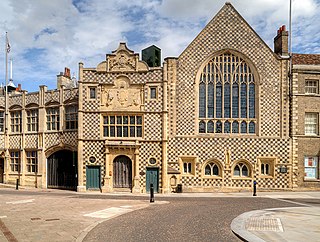
Norfolk is a ceremonial county in the East of England and East Anglia. It borders Lincolnshire and The Wash to the north-west, the North Sea to the north and east, Cambridgeshire to the west, and Suffolk to the south. The largest settlement is the city of Norwich.

Hunstanton is a seaside town in Norfolk, England, which had a population of 4,229 at the 2011 Census. It faces west across The Wash. Hunstanton lies 102 miles (164 km) north-north-east of London and 40 miles (64 km) north-west of Norwich.

Norwich is a cathedral city and district of the county of Norfolk, England, of which it is the county town. It lies by the River Wensum, about 100 mi (160 km) north-east of London, 40 mi (64 km) north of Ipswich and 65 mi (105 km) east of Peterborough. The population of the Norwich City Council local authority area was estimated to be 144,000 in 2021, which was an increase from 143,135 in 2019. The wider built-up area had a population of 213,166 in 2019.

Greenwich Park is a former hunting park in Greenwich and one of the largest single green spaces in south-east London. One of the Royal Parks of London, and the first to be enclosed, it covers 74 hectares, and is part of the Greenwich World Heritage Site. Surrounding the hilltop Royal Observatory and straddling the Greenwich Prime Meridian, it commands elevated views over the River Thames, the Isle of Dogs and the City of London.
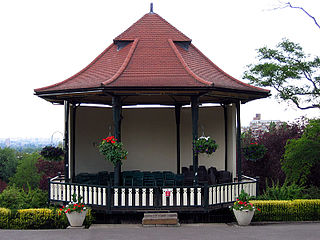
A bandstand is a circular, semicircular or polygonal structure set in a park, garden, pier, or indoor space, designed to accommodate musical bands performing concerts. A simple construction, it both creates an ornamental focal point and also serves acoustic requirements while providing shelter for the changeable weather, if outdoors. In form bandstands resemble ornamental European garden gazebos modeled on outdoor open-sided pavilions found in Asian countries from early times.

Mousehold Heath is a freely accessible area of heathland and woodland which lies to the north-east of the medieval city boundary of Norwich, in the English county of Norfolk.

Queen's Park is an area in North West London and West London, located partly in the City of Westminster and mostly in the London Borough of Brent. Some of the area within Westminster forms a civil parish, the first to be created in London since the right of communities to establish civil parishes was enacted in 2007. The area is located 4 miles (6.4 km) north-west of Charing Cross, and centred around a 30 acres (12 ha) park, which opened in 1887 and was named in honour of Queen Victoria. The area gives its name to Queens Park Rangers football club.
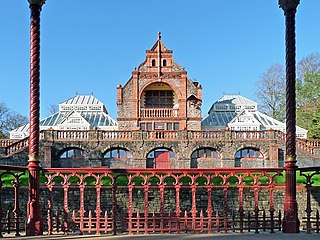
Belle Vue Park is a large Victorian public park in the west of the city of Newport, in South Wales. It was awarded a Green Flag Award in 2008 and has maintained the status for over a decade since. The park is listed on the Cadw/ICOMOS Register of Parks and Gardens of Special Historic Interest in Wales.

Beechwood Park is a thirty-acre public park situated in the eastern Beechwood area of the city of Newport, South Wales. The park is listed on the Cadw/ICOMOS Register of Parks and Gardens of Special Historic Interest in Wales.

Roath Park Cardiff, Wales, is one of Cardiff's most popular parks, owned by Cardiff County Council and managed by the Parks Section. It retains a classic Victorian atmosphere and has many facilities. The park has recently been awarded the prestigious Green Flag award to recognise its high quality and its importance to Cardiff. Roath Park has widely diverse environments across the park.

Hillsborough Park is a large parkland area in Hillsborough, Sheffield, South Yorkshire, England. It is situated three miles north-west of the city centre. It is owned by Sheffield City Council and is one of the 13 designated "City Parks".

The Norfolk and Norwich Hospital stood on a site in St Stephen's Road, Norwich, Norfolk, England. Founded in 1771, it closed in 2003 after its services had been transferred to the new Norfolk and Norwich University Hospital. Many of the buildings were then demolished and replaced by housing.
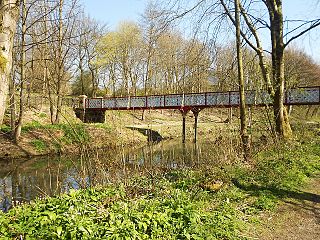
Queen's Park is a roughly circular 22 acres (8.9 ha) Victorian park lying on sloping ground to the north-west of Bolton town centre, in Greater Manchester, England. Opened as Bolton Park on 24 May 1866 by Lord Bradford it was renamed in 1897 in honour of Queen Victoria's Diamond Jubilee.

Roberts Park is a 14 acres (5.7 ha) public urban park in Saltaire, West Yorkshire, England. Higher Coach Road, Baildon, is to the north and the park is bounded to the south by the River Aire. A pedestrian footbridge crosses the Aire and links the park to the village of Saltaire. The park is an integral part of the Saltaire World Heritage site.

Mile Cross Estate is a council estate in Norwich, England. The population of the Mile Cross Ward in Norwich at the 2011 census was 10,655.
The following is a timeline of the history of the city of Norwich, Norfolk, England.

Eaton Park is a large public park located in Eaton, Norwich, England.
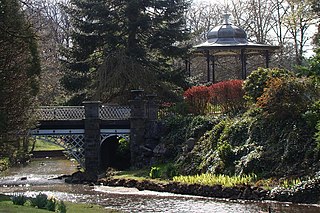
Buxton Pavilion Gardens is a Victorian landscaped public park in the spa town of Buxton in Derbyshire. The River Wye flows through the gardens, which are a Grade II* listed public park of Special Historic Interest.

Burslem Park is a public park in Burslem, Stoke-on-Trent, Staffordshire, England, operated by Stoke-on-Trent City Council. It was opened in 1894, and is essentially unchanged from the original layout. It is listed Grade II* in Historic England's Register of Parks and Gardens.























